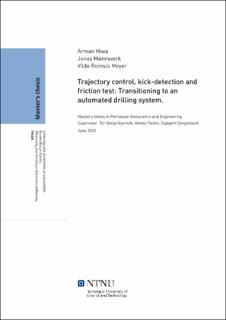| dc.contributor.advisor | Gjersvik, Tor Berge | |
| dc.contributor.advisor | Pavlov, Alexey | |
| dc.contributor.advisor | Sangesland, Sigbjørn | |
| dc.contributor.author | Hiwa, Arman | |
| dc.contributor.author | Mannsverk, Jonas | |
| dc.contributor.author | Meyer, Vilde Romslo | |
| dc.date.accessioned | 2021-09-24T17:44:56Z | |
| dc.date.available | 2021-09-24T17:44:56Z | |
| dc.date.issued | 2020 | |
| dc.identifier | no.ntnu:inspera:54976536:22221956 | |
| dc.identifier.uri | https://hdl.handle.net/11250/2781571 | |
| dc.description.abstract | Denne masteroppgaven var originalt tiltenk å dekke Fase 2 av Drillbotics konkurransen. Dette ble endret som følge av COVID-19 utbruddet. Arbeidet utført i forkant av COVID-19 er vedlagt, slik at det kan videreformidles til neste års NTNU lag. Videre vil denne oppgaven inneholde det nye omfanget, med nye problemstillinger. Hovedmålet forblir det samme, henholdsvis det å «utvikle, teste og validere teknologi som fremmer utvikling av autonom boring», men oppgaven er ikke lenger begrenset til miniatyr skala.
Motivasjonen for å benytte automasjon ligger i å frigjøre mennesker fra repetitive og monotone oppgaver, utvikle ny teknologi for å holde olje og gass industrien økonomisk bærekraftig, i tillegg til det viktigste aspektet - generell forbedring av sikkerhet. Overgangen fra menneskelig arbeidskraft til fullstendig automatiserte boresystemer burde foregå gradvis. Tre temaer ble valgt for videre undersøkelser i forhold til potensialet rundt automatisering, henholdsvis brønnbane kontroll, kick-gjenkjenning og friksjonstest. Modeller ble utviklet for alle tre temaene i MATLAB, og data ble innsamlet ved hjelp av OpenLab simulator.
Da brønnbane kontroll var en del av den originale oppgaven for Drillbotics konkurransen, ble informasjonen som allerede var tilegnet brukt for å undersøke en løsning for korrigering av uønskede avvik. En modell ble utviklet basert på «minimum-energi-kriteriet» og viser at en jevn brønnbane vil øke brønnkvaliteten.
Ukontrollerbare kicks under boreoperasjoner har potensialet til å påføre en brønn utblåsning. Derfor har en automatisk kick-gjenkjenner blitt utviklet og testet. Resultatene indikerer korrekt registrering av reelle kicks, men trenger derimot optimalisering for å minske mengden falske resultater.
En automatisk friksjonstest modell har blitt utviklet med intensjonen å avlaste de menneskelige operatørene for repetitive oppgaver. Modellen er brukt for å evaluere resultatenes hydrauliske avhengighet. Observasjoner indikerer at strømningshastighet sterkt påvirker test resultatene, mens effekten av tetthet er tilnærmet neglisjerbar. | |
| dc.description.abstract | This thesis was originally supposed to cover Phase II of the Drillbotics competition. However, it changed as a result of COVID-19. Work done prior to the outbreak is documented in appendices to convey the findings to next year's NTNU team. Henceforth, the content of this thesis will discuss the modified scope defined. The overall objective remains the same, respectively to "develop, test and validate technologies which enables autonomous directional drilling in the future". However, not limited to miniature scale.
Motives for utilizing automation includes releasing humans from performing repetitive and monotonous tasks, as well as developing new technology to keep the oil and gas industry economically feasible and most importantly improve overall safety. The transition from human labor to a fully automated drilling system should be carried out gradually. Three areas were chosen to further explore the automation potential, respectively trajectory control, kick detection and friction test. Models developed for all three areas utilizes OpenLab drilling simulator to collect necessary data.
As trajectory control was part of the original scope for Drillbotics competition, the knowledge already acquired was used to investigate a solution for correcting unwanted deviation. Using the minimum-energy criterion a model for testing is created. Results show smooth well paths will increase overall borehole quality.
Uncontrolled kicks during a drilling operation have the potential to cause a well blowout. Therefore, an automated kick-detection model has been created and tested. Results indicate proper detection of actual kicks, however, it requires a reduction of false test results.
An autonomous friction test model has been designed with the intention to offload the human operator of repetitive tasks. The model is used to evaluate the hydraulic dependencies on the recordings. Findings indicate that flow rate greatly impacts the test results, while the impact of density is close to negligible. | |
| dc.language | eng | |
| dc.publisher | NTNU | |
| dc.title | Trajectory control, kick-detection and friction test: Transitioning to an automated drilling system. | |
| dc.type | Master thesis | |
